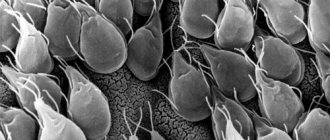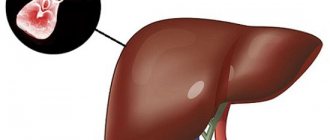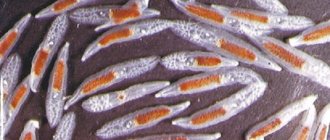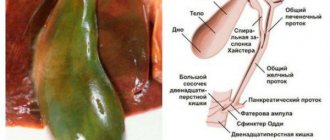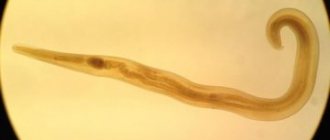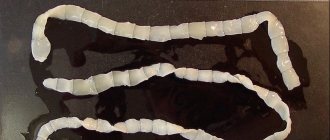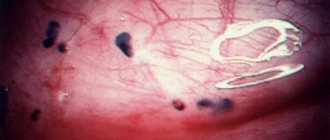Fluke class
The class of flukes includes about 4,000 species that parasitize the internal organs of humans and various animals.
A representative of the class is the liver fluke, which lives in the liver of cattle. It has oral and ventral suckers. With their help, the worm is kept inside the host's liver. The fluke feeds on blood, sucking it through the oral sucker.
Liver fluke. Its residence in the liver leads to the destruction of the walls of the bile ducts, sometimes parasites clog them. In addition, metabolic products of the parasite have a harmful effect on the host organism in which the fluke lives. The life cycle of a parasite is very complex. Fertilized eggs are released through the host's intestines.
Once in the water, microscopic larvae equipped with cilia develop from the eggs. They penetrate the body of the small pond snail mollusk, in which they grow, multiply, and tail larvae appear.
These larvae leave the mollusk, actively swim in the water, then attach to plants, cast off their tail, and become covered with a thick shell—a cyst is formed. With grass or water, the cyst enters the cow's intestines, where it develops into an adult worm. A person can become infected with liver fluke if he drinks water from a dirty pond.
Another parasite that can infect humans and mammals (dogs, cats, wolves, etc.) is the cat fluke.
Unlike the liver fluke, its life cycle occurs with the participation of two intermediate hosts: a freshwater gastropod - bithinia - and freshwater cyprinid fish. A person or animal becomes infected with cat fluke when they eat raw, insufficiently salted or cooked (fried) fish.
Appearance
Fasciola hepatica is called a worm, which belongs to the flat class. The shape of the liver fluke resembles a leaf and is localized in the liver. That's why parasites got their name. There are suckers on the body, which are localized in the oral and abdominal parts of the parasite.
The liver fluke is a gigantic trematode that reaches a length of up to 6 cm. It is localized mainly in the liver, attaching to the walls with suction cups, mechanically damaging it. That's why worms are called liver worms. With prolonged infestation, the worm pulls all the nutrients from the organ, which causes serious health problems. The fluke cannot live outside its owner.
The fluke is classified as a hermaphrodite. One worm can produce an entire population of worms.
What organs does the liver fluke affect?
Entering the human digestive tract with food, helminths penetrate the abdominal cavity, and then into the liver and bile ducts, where they attach to tissues. If you notice signs of a liver fluke, you should not put off visiting a doctor! You need to know that these worms begin to suck out nutrients and actively parasitize the body, causing severe harm to various internal organs.
Liver fluke. Fasciola hepatica (liver fluke) becomes the causative agent of fascioliasis, a disease that not only affects the liver and bile ducts, but also causes severe allergic reactions, even anaphylactic shock is possible.
Human organs further affected by the liver fluke (through the bloodstream) include the lungs, skin and even mammary glands. With the long-term presence of the parasite in the body, severe diseases of the gastrointestinal tract, blood vessels, heart, and nervous system develop, and an oncological process may begin.
The first signs of a liver fluke are associated with the incubation period of the development of the parasite.
The liver fluke, penetrating through the above routes of infection, affects the human hepato-biliard system, which includes the gallbladder, bile ducts and the favorite delicacy of these worms - the liver.
It is typical for the parasite to reside and parasitize in the liver and bile ducts. Fascioliasis is a very unpleasant and dangerous disease, especially at an advanced stage. Since during this period, along with allergic and neurogenic factors, patients experience severe complications in the form of complete blockage of the bile ducts, multiple sclerosis and atony of the gallbladder.
How to determine chronic opisthorchiasis
The parasitic disease develops into a chronic stage several months after the parasite enters the body. At the same time, the symptoms of infection with the liver fluke come to the fore , indicating damage to the liver and biliary tract, in particular:
- the patient experiences paroxysmal pain in the right side,
- jaundice develops
- In addition, patients complain of diarrhea, bloating, and weakness.
The longer the liver fluke is not detected, the worse the prognosis. In advanced cases, liver cirrhosis develops. Migration of the liver fluke throughout the body can lead to its entry into atypical organs: the stomach, under the skin, lungs and others.
Our readers write
Topic: Parasites are to blame for all troubles!
From: Elena V.
I have felt very bad for the past few years. Constant fatigue, insomnia, some kind of apathy, laziness, frequent headaches. I also had problems with digestion, and in the morning I had bad breath.
And here is my story
All this began to accumulate and I realized that I was moving in some wrong direction. I began to lead a healthy lifestyle and eat right, but this did not affect my well-being. The doctors couldn’t really say anything either. Everything seems to be normal, but I feel like my body is not healthy.
Then I went to an expensive clinic and had all the tests done, and in one of the tests I was found to have parasites. These were not ordinary worms, but a specific type, with which, according to doctors, almost everyone is infected, to a greater or lesser extent. It is almost impossible to remove them from the body. I took a course of antiparasitic medications that were prescribed to me at that clinic, but there was almost no result.
A couple of weeks later I came across an article on the Internet. This article literally changed my life. I did everything as it was written there and after just a few days, I felt significant improvements in my body. I began to get enough sleep much faster, and the energy that I had in my youth appeared. My head no longer hurts, my mind became clearer, my brain began to work much better. My digestion has improved, despite the fact that I now eat haphazardly. I took tests and made sure that no one else lives in me!
Anyone who wants to cleanse their body of parasites, no matter what types of these creatures live in you, read this article, I’m 100% sure it will help you!
Occasionally, multiplying worms completely clog the ducts with the products of their vital activity, thereby complicating the outflow of bile, which as a result can lead to the development of acute cholestasis.
Metabolic products of the liver fluke cause increased sensitivity of the body, which leads to various allergic reactions, which become especially pronounced in the last stage of fascioliasis.
The general condition of the patient is individual, depending on how severely the organ was affected.
How to be treated
The treatment of fascioliasis is based on the use of antiparasitic drugs. The most effective, according to modern ideas, is praziquantel. This medicine has many side effects and contraindications, so it should be prescribed only by the attending physician after examination and confirmation of the diagnosis.
If there are problems with bile secretion or anemia has developed, the patient receives appropriate treatment. During treatment, the patient is observed by a therapist; perhaps also an infectious disease specialist and parasitologist. After a certain time after the end of the course of antiparasitic therapy, the doctor orders a repeat stool sample for analysis to ensure that the patient has been cured.
Expert of the site Pokhmelye.rf. Gastroenterologist Daniela Purgina warns against a common mistake.
Do not try to treat yourself for parasites. The fact is that antiparasitic drugs are quite toxic, and their irrational use can lead to toxic damage to the liver.
Developmental cycle of the liver fluke
During their existence, these helminths go through several stages.
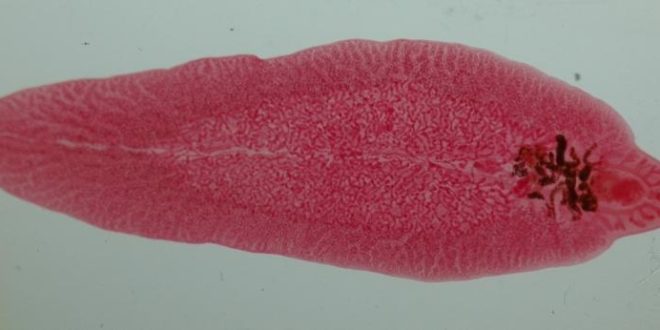
The stages of development of the liver fluke have a certain sequence:
- the first larval stage is the miracidium, which emerges from the egg and floats in the water until it penetrates the body of the mollusk;
- after this implementation, a sporocyst is formed, which begins to reproduce by parthenogenesis;
- The further stage of the life cycle of the larvae of these helminths is redia, the structure of which already contains the rudiments of organ systems. Also in their body there are germ cells, from which a new larval form - cercariae - is parthenogenetically hatched;
- A special feature of the structure of the cercaria is the presence of a brain, an eye and a powerful tail, which gives it freedom of movement. At this stage, the larva emerges from the mollusk, trying to quickly get out of the water;
- The cercaria on land transforms into a cyst, losing its tail, and attaches to coastal plants. This stage is called adolescaria. So the fluke can stay for a very long time until it enters the body of a person or animal that feeds on grass;
- After successful introduction of the larva into the host's body, it is transformed into a sexually mature individual - marita. At this stage, the trematode lays eggs (thousands of eggs per day!), then they are released along with feces into the external environment. If they get into the water, the helminth development cycle repeats.
Fasciola is characterized by frequent transformations and changes of hosts. The life cycle of the liver fluke is represented by the following chain: final host; egg; miracidium; intermediate host (pond snail); sporocyst; maternal redia; daughter redia (cysts); cercariae; adolescary; adolescaria in the external environment.
The liver fluke begins to develop from an egg from which a miracidium emerges. The larva has a nerve ganglion, excretory organs and a light-sensitive eye. The germ cells are located in the back. The front part of the body has a gland that produces an enzyme that dissolves living tissue and penetrates the intermediate host.
Liver fluke. The parasite is covered with cilia and actively moves in the aquatic environment. It feeds on substances accumulated in the egg. At the next stage of its life cycle, the liver fluke becomes a sporocyst. This larva looks like a shapeless sac without organs, excretory and nervous systems.
At this stage, reproduction occurs without fertilization using germ cells. The sporocyst bursts and redia emerge, which parasitize the same host. Rediae have a number of formed organs: mouth, digestive tube and pharynx, opening for the release of eggs.
Each cyst contains germ cells from which the next larval generation, cercariae, is formed. The cercarium has suckers, a gut, an excretory system, and a nervous system. The larva has a long muscular tail. The cercarium emerges from the mollusk and moves in the water.
Free-swimming cercariae attach to plant stems and objects in water, becoming covered with a membrane. This stage is called adolescaria. The future fluke has a spherical shape.
If the larva is swallowed by an animal from among the definitive hosts, then the fasciola shell dissolves in the intestines of the host and the helminth enters the liver, where it develops to a sexually mature state. Infestation of animals occurs when they eat grass in water meadows and when drinking water from contaminated reservoirs. Humans are infected through contaminated vegetables.
The first signs and symptoms of liver fluke
- Acute - appears at the stage of larval migration, lasts up to one and a half months. The symptoms of the disease manifest themselves most strongly when the larvae penetrate from the intestines into the liver.
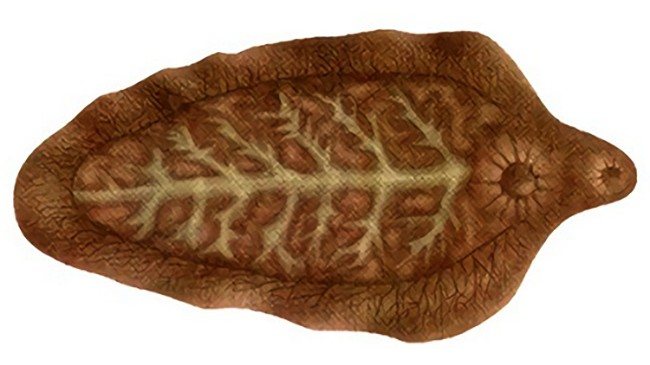
Occasionally, the maturation of the larvae can pass through the pancreas or soft tissues and, while moving towards the liver, injure them.
- allergy;
- temperature rise to 40;
- loss of appetite;
- constipation or diarrhea;
- joint pain;
- headache;
- nausea;
- pain in the right hypochondrium.

Abdominal pain and weakness
The stage lasts about two months; if no treatment measures are taken, the helminths continue their destructive work.
- The chronic stage at which the liver fluke aggravates the symptoms described above. Phase 2 of the disease is characterized by:
- chronic fatigue;
- constant pain inside the liver;
- weight loss;
- loose stools;
- high irritability;
- cholecystitis, hepatitis, heartburn.
As a result of their vital activity, parasites secrete toxins, which, entering the blood, constantly poison the body, which negatively affects the general condition.
It is worth noting that liver flukes cause symptoms in the body, which, if ignored, carry a high probability of the chronic form becoming advanced, which can lead to liver edema, bile duct obstruction, and peritonitis.
Signs of the presence of a parasite in the body
Diseases caused by flukes can have different names:
- by the names of the participants - opisthorchiasis, dicroceliosis, fascioliasis;
- by its common name - trematodosis.
Signs of infection are associated either with the body’s reaction to the initial penetration of liver parasites, or with their vital activity.
Acute infection
The body's primary reaction to parasites is acute allergosis. Signs of a liver fluke include:
- temperature increase;
- pain in muscles, joints;
- itching;
- cough, bronchitis, shortness of breath;
- sharp pain in the abdomen;
- enlarged lymph nodes.
Liver flukes should be suspected if these symptoms occur within a month after eating fish.
Chronic illness
Liver worms live in the organ for years without treatment. From time to time, individuals can clog the bile ducts. In the chronic phase, infection manifests itself as follows:
- pain under the ribs and in the upper abdomen on the right;
- signs of bile stagnation, inflammation of the pancreas and gall bladder;
- liver enlargement;
- nausea.

About half of those infected have no symptoms.
Internal structure of the liver fluke
In humans, the causative agent of fasciola can be either Fasciola vulgaris or giant fasciola. Both have a specific and almost identical structure and functioning, which is due to their parasitic lifestyle. Let's consider the internal structure of the liver fluke.
The parasite has a leaf-shaped body, 2-7 cm in size and grayish-yellow color. Lives in the bile ducts, liver and pancreas of vertebrates. With the help of oral and abdominal suckers, it is attached and held on the walls of the ducts.

The fluke is characterized by simplification and specialization in the structure of some organs. This is due to her parasitic lifestyle.
The specialization includes suckers, spines and other formations on the body of the worm, powerfully developed genital organs and several complex life cycles. Morphological simplification is expressed by the absence of sensory organs in sexually mature individuals, which act as endoparasites
The main vital systems of a worm:
- digestive - the mouth opening is connected to the muscular pharynx (sucking apparatus). Behind the pharynx there is a branched esophagus and blindly ending intestines;
- nervous - is a peripharyngeal nerve ring, from which three pairs of nerve trunks arise (the lateral ones are the most developed). The nerve trunks are connected by bridges, which makes them look like a lattice;
- excretory – developed protonephridia deep in the parenchyma. Thermal cells have channels with cilia, which select tissue fluid and dissimilation products from the parenchyma. Cilia move fluid through the channels and excretory pores, removing it from the body;
- sexual – the helminth is a hermaphrodite. The male reproductive system is represented by a pair of testes, two vas deferens, which merge into the ejaculatory duct and the cirrus. The female reproductive system is more complex: ovary, vitelline, spermatheca, ootype (fertilization and formation of eggs occurs in it), uterus and genital opening. In some species, fertilization occurs in the spermatheca. In most cases, insemination is cross-insemination, but there are also cases of self-insemination.
The use of folk remedies
Elimination of liver fluke is possible using folk remedies:
- Birch tar - dosage regimen: add two drops of birch tar to ¼ glass of milk and drink 60 minutes before meals. On the second day, add four drops of tar to the same amount of milk. And so increase the dosage daily by two drops until the fifth day. From the sixth day, the dosage must be reduced by two drops of tar. On the ninth – final day, the amount of medicine taken will again be 2 drops in ¼ glass of milk. You can repeat the course of treatment after three weeks.
- Garlic enema - add a crushed clove of garlic to one glass of water, leave, strain, and give an enema.
- Lemon decoction - pour the juice squeezed from one lemon into 200 ml of water, boil for 5 minutes, then drink on an empty stomach.
- Pomegranate broth - pour 1 tsp into a glass of water. chopped pomegranate peel, boil, let it brew and then strain. Drink 1 tbsp three times a day on an empty stomach.
The use of traditional medicine against worms is permissible only after consultation with a doctor and his approval for such procedures.
Video: liver fluke.
Diagnosis of liver fluke
Due to the fact that the liver fluke has an unusual development cycle, it is extremely difficult to diagnose.
Fascioliasis is characterized by a dangerous feature: making a diagnosis of the acute phase is extremely problematic, since the life cycle of the liver fluke has not yet completed and the eggs, which are released with feces only after 4 months, are not excreted from the body. Then doctors focus on the medical history; when making a diagnosis, they have to separate fascioliasis from diseases caused by other types of helminths.
To confirm the diagnosis, laboratory tests of the patient's stool are performed twice. If yellow eggs with a cap on one side are found inside, this is the main factor for the final conclusion. In case of doubt, the bile of the infected person is examined.
It is very effective to conduct a blood test, the analysis of which, if infection has occurred, shows a noticeable excess of leukocytes and a decrease in the total amount of protein. But at the stage of a chronic disease, this procedure is practically useless, since all blood cells return to normal.
Based on the presence of fluke eggs in feces, liver fluke is diagnosed. The parasite can be detected in healthy people after drinking contaminated water or food. Eggs begin to be excreted in feces 3-4 months after infection.
In the acute stage of fascioliasis, the diagnosis is made on the basis of painful symptoms.
The following methods are used in the diagnostic process:
- collecting anamnesis, that is, epidemiological data: swimming or drinking water from stagnant bodies of water, eating unwashed vegetables, fruits, as well as fish, meat or animal liver;
- clinical signs of pathology: early symptoms and signs of chronic fascioliasis;
- laboratory tests depend on the stage of the disease. In the early phase, serological methods are used, that is, studying the blood for antibodies - ELISA, RNGA reactions. In advanced stages, copro-ovoscopy or duodeno-ovoscopy is performed.
Based on the results of the diagnostic procedures performed, the doctor makes a final diagnosis and prescribes a treatment regimen for the helminth.
Diagnosis
After examining and interviewing the patient, the doctor directs him to undergo tests that will help in making a diagnosis:
- Blood analysis. If patients have fascioliasis, then the blood plasma has a high content of leukocytes and eosinophils.
- A stool test is performed 90-120 days after infection, when the parasite begins to lay infective eggs. The diagnosis is confirmed if eggs are found in human stool.
- Study of duodenal contents of the liver. With fascioliasis, the doctor diagnoses the presence of worm eggs. The test gives a positive result only 4-5 months after infection.
- Ultrasound. Fascioliasis is confirmed by the presence of flukes in various human organs and tissues.
It will also be interesting: How to get tested for demodicosis?
Once the correct diagnosis is made, treatment must be started immediately.
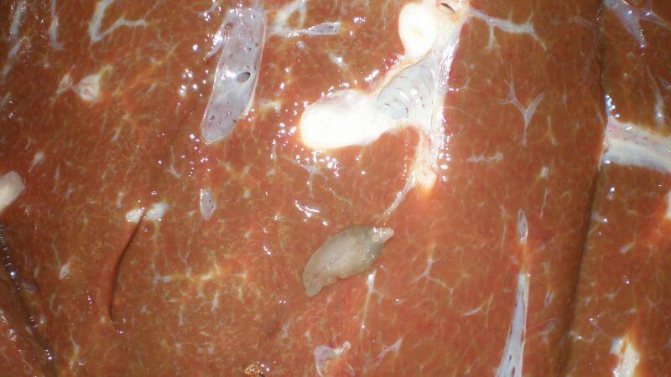
Intermediate host
The intermediate host of the liver fluke is a freshwater creature, usually a mollusk. The parasite larva enters his body, splitting the walls of his body, and begins to develop, passing through several stages. After the parasite has reached the redia stage, it multiplies and releases cercariae larvae into the reservoir, which are already similar in structure to the adult individual.
Cercariae are able to move, have a respiratory system, but they do not yet feed; vital activity occurs due to the accumulated useful substances at the previous stage. Larvae entering the external environment are able to remain there for a large amount of time. On the shore of a reservoir, they shed their tail and become covered with a hard film. This stage is called adolescaria.

Under some circumstances, the intermediate host of the liver fluke can be not only a mollusk, but also some species of freshwater fish. In this case, the larvae are not released into the external environment, although they can remain in it unhindered, waiting for a permanent host.
Damage to liver tissue and bile ducts
Herbivores that eat grass near a pond or drink water from it can become infected with the parasite. An animal cannot protect itself from infection on its own, so farmers are advised to monitor the condition of their livestock daily.
By consuming contaminated fish, humans are also at risk; this happens if the product has not undergone sufficient heat treatment. Raw fish can cause catastrophic consequences to the human body. It is recommended to buy the product only in places where they can provide a veterinary certificate for it. This document indicates that the fish is safe to eat.
It is noted that the main host of the liver fluke is a warm-blooded, vertebrate animal, in whose body the parasite feels itself in favorable conditions, so it actively grows and reproduces. The disease is often diagnosed in cattle and humans. Cattle become infected by eating grass near a pond or by drinking raw water from a lake or puddle.
The eggs of an adult helminth enter the host’s body mainly through the mouth along with food or water; the highest concentration of larvae is subsequently observed in the liver and gall bladder. The liver fluke attaches to the mucous membranes of the body and sucks out all the useful components from them.
In addition, intoxication occurs, it is caused by the fact that the parasite has a respiratory system. With each exhalation of an adult, a toxic gas enters the body of the infected person, which destroys organs from the inside.
Diagram of the life cycle of the liver fluke
There is a high probability that the final host of the liver fluke will be a person, since he can become infected with the parasite under many circumstances. The most common situations are conventionally noted:
- Prolonged stay in open bodies of water can be dangerous for humans, because the parasite larvae easily attach to the skin of people. In addition, accidental ingestion of water while swimming can cause liver flukes to enter the body directly through the mouth. For this reason, the best option for this type of water treatment is an indoor pool.
- The ability of the parasite to survive in the external environment for a long time makes the consumption of insufficiently processed fish from a reservoir dangerous for humans. Helminths die only at very high and low temperatures. For this reason, frozen river fish is mainly sold on the market.
- Drinking raw water, especially by children, can lead to the appearance of liver fluke in the body. The problem is that the liquid is not properly pre-cleaned. It is safer to boil or filter the water first. Still mineral water is a good choice to quench your thirst.
Intestinal upset is one of the symptoms of the disease
When the liver fluke enters the human body, opisthorchiasis begins to spread in the patient. Disturbances in the functioning of internal organs occur, and intoxication of the body appears.
It is impossible to completely protect yourself from helminths, but by following basic rules you can significantly reduce the risk of diseases. However, if you observe the first symptoms, there is no need to waste time; timely consultation with a doctor will lead to a quick recovery.
As soon as the larvae enter the body of the final host, and this can be an animal or a person, they continue their development to sexually mature individuals. Acceptable environments for the survival of the parasite's offspring are animal and human excrement. With them, the worm eggs end up in water bodies, repeating their life cycle. This stage is called aledoscaria.
The worm can exist in an aquatic or humid environment for a long period of time, maintaining its viability.
The pond snail is an intermediate host of the liver fluke. The parasite larva invades the snail's body, where it lives and develops at its expense. An already grown individual leaves its carrier and attaches itself to the stems of aquatic and coastal plants using suction cups and spines on its body. At this stage, the helminth is covered with a protective shell - a shell.
Treatment of fascioliasis
If the question of how a person can become infected with a liver fluke has become relevant to you, you have probably already identified some of the symptoms described above. In this case, you should immediately seek qualified help.
And as we have repeatedly said, the liver fluke is very dangerous and treatment of the consequences of its vital activity should be carried out only in a hospital.
- Preparatory, in which acute symptoms of the disease are relieved. The patient takes choleretic and hepatoprotective drugs aimed at removing toxins and promoting liver restoration. The first course lasts for a week.
- Destruction of worms. For this purpose, the patient takes anthelmintic medications. However, we should not forget about the high toxicity of probiotics; this is where traditional medicine comes in handy.
- Recovery phase. A very important stage for the recovery of the body. Involves taking medications that promote liver regeneration, as well as choleretic drugs aimed at cleansing the bile ducts of dead worms.
- purulent cholangitis;
- acute pancreatitis;
- tumors of the liver, pancreas;
- biliary peritonitis.
With timely diagnosis of the disease, treatment of fascioliasis gives a positive prognosis, which cannot be said about the advanced stage of the liver fluke with the development of complications. After completing the full course of therapy, it is especially important to follow a diet in the next month; also, after three months, you should be re-tested for the presence of liver fluke inside the body, to exclude the possibility of secondary infection. After recovery from this disease, you develop a stable immunity to it.
Do not forget that self-medication is dangerous to your health.
Symptoms of the disease
The liver fluke is an insidious helminth that can remain silent for many months, but at the same time severely disrupt the functioning of the liver. It is possible to determine whether a person has a parasite or not only in laboratory conditions, but you should pay attention to the following symptoms:
- Pain in and around the liver, usually the pain is localized in the right hypochondrium. It can occur at any time of the day, and can be acute or dull;
- Problems with stool due to poor excretion of bile, constipation may be replaced by severe diarrhea;
- Constant nausea, especially before or after meals, often accompanied by vomiting;
- The presence of weakness, which is rarely expressed at first, but then develops into chronic fatigue;
- An elevated temperature and subsequent fever with cold sweat also indicate the presence of a liver fluke.
If the symptoms torment a person, he should definitely seek help from a doctor. The doctor should conduct a conversation, find out whether the patient eats fish, and poorly cooked fish, and whether he is often in the wild, and then refer him for stool and blood tests, which will allow him to recognize the disease.
Good afternoon No, it is impossible to become infected from a sick person. Even if it excretes helminth eggs with feces, the larvae that appear at this stage of development survive only in the body of the intermediate host (mollusk).
Good afternoon The parasite larvae die if the liver is thoroughly boiled, but it is not recommended to eat infected offal.
Diagnosing fascioliasis is quite difficult. First of all, the doctor:
- studies medical history (anamnesis). At the same time, the doctor collects information about the patient’s gastronomic preferences, his place of residence and work, as well as whether he has visited exotic countries;
- conducts a visual inspection;
- performs palpation (feeling) of the abdomen;
- examines the results of blood tests, if available;
- looks at the ultrasound results, if available;
To confirm infection with the liver fluke, a stool test is performed to check for parasite eggs. They are secreted with bile from the bile ducts and enter the intestines, and from there, with intestinal contents, out. If the liver is damaged, the situation is complicated by the lack of egg secretion.
Additionally, immunological tests for parasites and computed tomography or magnetic resonance imaging can be performed to clarify damage to other organs.
Miracidium of the liver fluke
The fasciola egg begins to develop only when it gets into the water, where, under favorable conditions, after 25-30 days, a larva emerges - the miracidium. Miracidium has a nerve ganglion, a light-sensitive organ “eye”, and excretory organs. In the back part there are germ cells.
The anterior end of the body is equipped with a gland that produces an enzyme capable of dissolving living tissue upon penetration into an intermediate host. The miracidium is covered with cilia, thanks to which it actively floats in water. It does not feed, but exists due to the nutrients accumulated in the egg.
Liver fluke. Inside the body of the miracidium there are special germ cells capable of parthenogenetic development. Miracidium actively invades the body of the intermediate host of the small pond snail. In the body of the mollusk, the miracidium sheds its ciliated cover and penetrates the host’s liver.
The parasite then develops into the next larval stage, the sporocyst. Sporocysts resemble a shapeless sac, devoid of any organs, including the nervous and excretory systems. This larval stage is capable of reproduction.
In the sporocyst, a new larval generation, the redia, develops parthenogenetically (i.e., without fertilization) from the germ cells. The sporocyst bursts, and the redia come out of it, but continue to parasitize the same host.
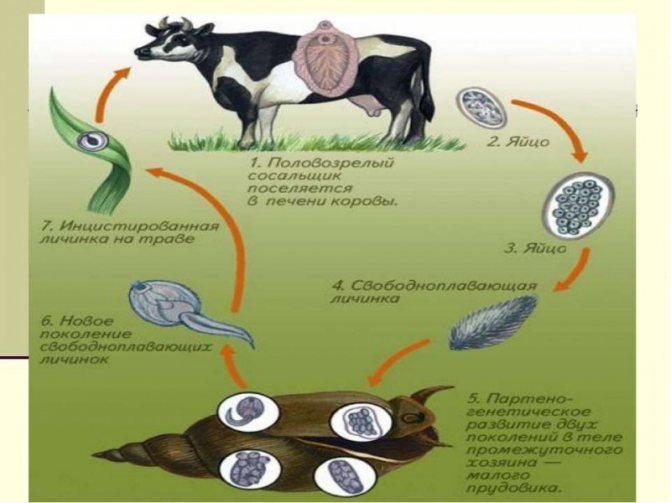
A number of organs are already being formed in redia: the mouth, pharynx, digestive tube and the opening for the exit of individuals of the new generation. Inside the redia, the next larval generation, the cercariae, is also parthenogenetically formed from the germ cells.
The body of the cercarium contains many organs characteristic of marita. It has suckers, intestines, nervous and excretory systems, but unlike the adult form, it is equipped with a long muscular tail, which provides forward movement. The cercarium leaves the mollusk and actively moves in the water.
Next, free-swimming cercariae attach to some object, such as plant stems, and become covered with a membrane. In this larval stage, called adolescaria, the fasciola is spherical in shape. If adolexaria is swallowed by an animal from among those that are the final hosts of fasciola, then the shell dissolves in the intestine of the host and the parasite penetrates the liver, where it reaches a sexually mature state.
Liver fluke. Thus, in the life cycle of Fasciola, the invasive (i.e., capable of infecting) stage for the intermediate host is the miracidium. For the definitive host, this stage is adolescaria.
Livestock most often become infested by eating grass in flooded meadows and by drinking water from reservoirs where Adolescaria may be present. People usually become infected through vegetables (most often lettuce) that are watered with water from reservoirs containing adolescaria.
It is interesting to note that in the life cycle of Fasciola there is a free-living stage - the miracidium, which is morphologically close to ciliated worms, which serves as one of the proofs of the origin of flukes from ciliated worms.
What increases the risk of infection
Infection is mainly caused by eating plants (both from the garden and growing in the wild) that have been watered with water taken from fresh water bodies where infective larvae may be found. Infection can also occur by drinking unboiled water or ingesting river water.
Fecal-oral and waterborne routes of infection are the main ones. That is, in order for trematodes to parasitize in the body, they need to be in the gastrointestinal tract.
Who is at risk? The following categories of people are at greatest risk of infection:
- people involved in agriculture and livestock raising;
- fishermen;
- hunters
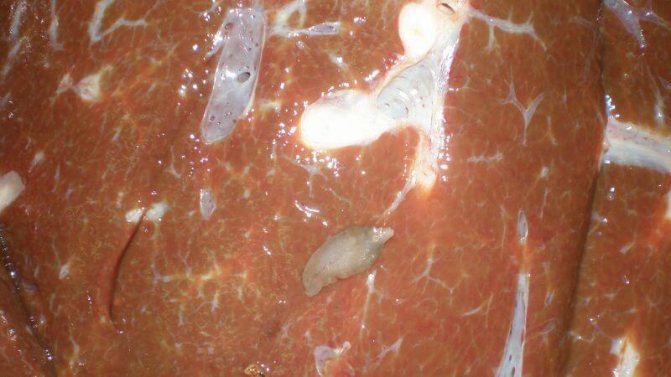
Despite this, anyone can become infected by swimming in a body of water contaminated with feces and swallowing water.
Prevention of liver fluke
To minimize the risk of infection with liver fluke, it is necessary to adhere to preventive recommendations.
Prevention of fascioliasis consists of the following rules:
- maintaining cleanliness in everything. Wash your hands after using the toilet and before every meal. It is necessary to thoroughly wash salad herbs, vegetables and fruits, if possible, pour boiling water over them or blanch them before use;
- Particular attention should be paid to the heat treatment of products. Boil or stew fish caught from a pond, even if it is intended for pets (cats are carriers of fascioliasis). Do not eat raw meat or liver;
- Avoid drinking unboiled or untreated water from stagnant bodies of water. It is not recommended to swim in stagnant water;
- Regularly conduct anthelmintic treatment of pets. Comply with sanitary and veterinary standards. It is also recommended to clean ponds and fight against mollusks (the intermediate host of helminths) in water bodies.
The liver fluke is not the most dangerous representative of flatworms, but since the ways of its infection are known, it is better to follow the rules of prevention. At the first symptoms or suspicion of invasion, you must contact an infectious disease specialist and gastroenterologist.
- drinking purified or boiled water;
- thorough washing of vegetables, fruits and herbs;
- purchasing meat and fish products only at certified points of sale;
- swimming only in proven bodies of water;
- heat treatment of products;
- inadmissibility of neglecting the rules of personal hygiene;
- deworming of pets.
By following these preventive measures, you will not only be protected from such a parasite as the liver fluke, but you will also have an overall high resistance to infections.
Public prevention of the disease involves the mass destruction of pond snails located on the banks of reservoirs. Particular attention is paid to livestock: they vaccinate, try to isolate pastures, as well as water bodies from nearby settlements.
Routes of infection
A person becomes infected with worms only orally, by ingesting their infective larvae. The route of infection depends on the type of fluke and its life cycle.
This may occur under the following circumstances:
- When swimming or drinking contaminated water from open water bodies - when larvae of Fasciola vulgaris or giant fasciola are accidentally swallowed. This is how people become infected with fascioliasis.
- The same thing happens when eating poorly washed garden greens, vegetables and fruits on which adolescaria are found.
- Infestation by cat or Chinese fluke occurs when eating uncooked fish or crayfish infected with larvae. As a result, the infected person falls ill with opisthorchiasis or clonorchiasis, respectively.
- You can become infected with the lanceolate fluke by accidentally ingesting an ant containing a parasite larva, a metacercaria, along with a berry or fruit.
Treatment of enterobiasis in adults. Find out how to treat liver echinococcosis here.
You can see a table of parasitic flatworms by following the link:
People at increased risk for trematode infections caused by flukes include:
- peoples who use traditional raw fish dishes;
- fishermen, hunters and outdoor enthusiasts who are in close contact with land and water;
- children playing in nature;
- sellers of fish products.
Important. A person infected with liver fluke is not dangerous to others as a source of infection. To become invasive, the helminth eggs it secretes must undergo development in intermediate hosts. Only after turning into adolescaria or metacercariae do they become dangerous to their final hosts.

Diagnosis
The diagnosis of infection with trematodes by flukes is made when their eggs are detected in the stool or duodenal contents. The intestines and duodenum communicate with the bile ducts, so the eggs laid in them by parasites easily enter the gastrointestinal tract.
Symptoms of cysticercosis in an adult. Find out how to get tested for eggworm here.
Read about the treatment of enterobiasis in children at the following link:
In the early stages of the disease, in the absence of eggs, good results are obtained by serological tests that detect antibodies to parasite antigens in the blood serum.
Attention. Liver fluke eggs can also be found in healthy people if they have eaten the liver of an infested animal. Such eggs are called transit eggs. They cannot cause infections because they need to undergo development in intermediate hosts. But they can cause misdiagnosis. Therefore, it is advisable not to eat the liver of any animals before the examination.
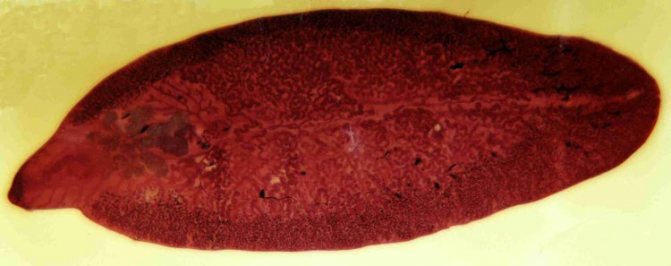
Prevention
All possible preventive measures arise from the ways in which infection occurs:
- You should not swim in polluted waters.
- Drink untreated, unboiled water.
- Eat vegetables and fruits that have not been washed with running tap water.
- Eat raw or half-raw fish and crayfish.
- You need to wash your hands often when you are in a place where flukes are possible.
- The contents of latrines and toilets must be properly disposed of. Do not allow feces, which may contain fluke eggs, to get into the soil or water bodies.
State sanitary services monitor fish products sold in markets and stores and conduct sanitary education activities among the population.

